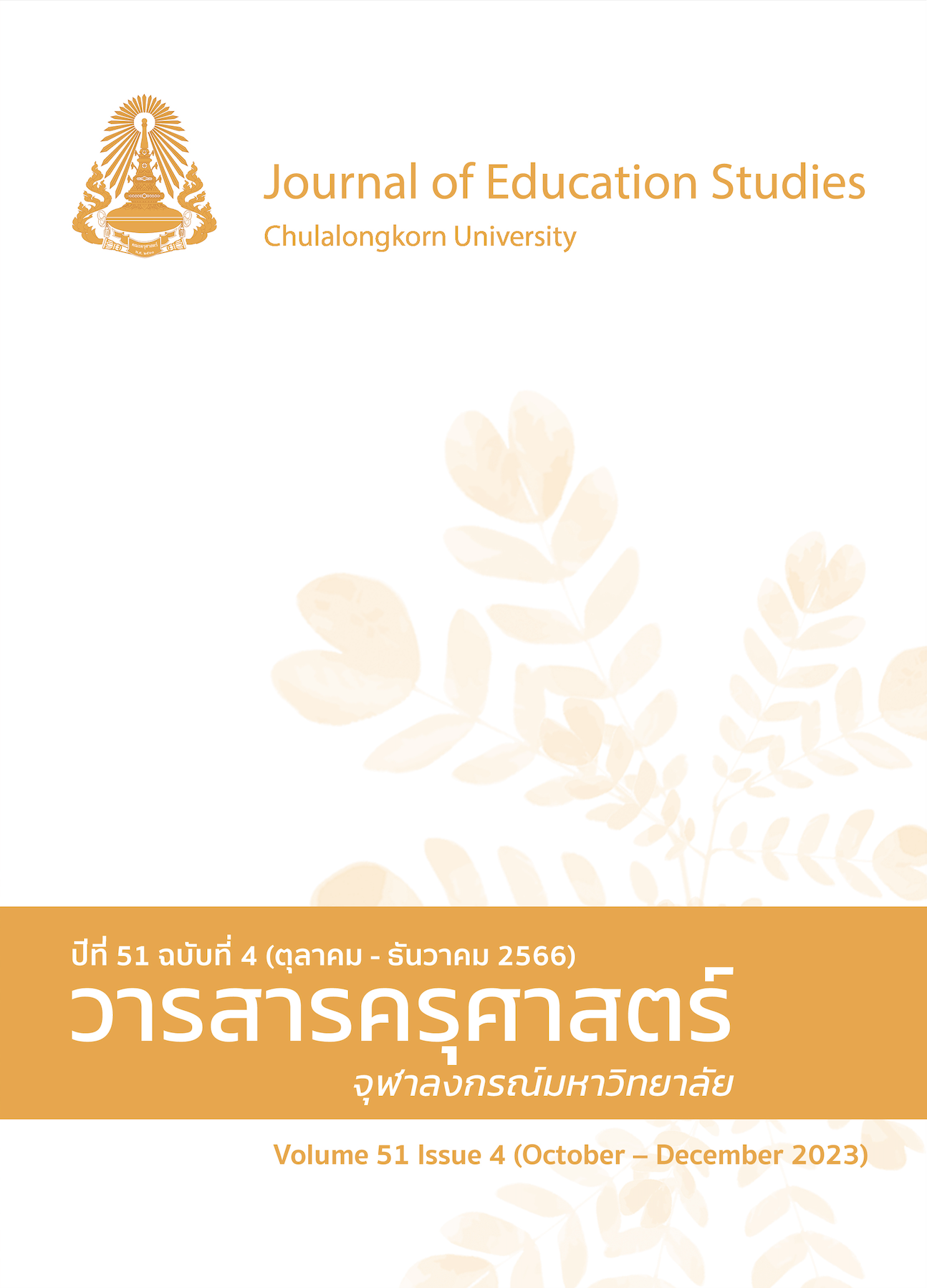Symptoms of Music Performance Anxiety of Youth Orchestra Musicians
DOI:
https://doi.org/10.14456/educu.2023.33Keywords:
music performance anxiety, youth orchestra, music performanceAbstract
Music performance anxiety (MPA) is a general phenomenon that happens to musicians. Orchestral musicians tend to experience higher levels of performance anxiety compared to individuals in other performing arts. The purpose of this research was to investigate the symptoms of MPA in youth orchestral musicians. The samples of this research were 72 current members of youth orchestras in Thailand. The research instrument used was the MPA symptoms questionnaire for youth orchestra including 67 items of the 6-level rating scale, developed from the previous MPA questionnaire, consisted of Music Performance Anxiety Inventory for Adolescents and Performance Anxiety Questionnaire, by the researcher. The data were analyzed using descriptive statistics. The results revealed that the average frequency of MPA in orchestral youth musicians is such that symptoms occur almost rarely or occasionally. Moreover, psychological symptoms tend to occur more frequently than physical symptoms. The average level of nervous symptom before performances is the highest. This study promotes music teachers' ability to prepare young musicians to be aware of the MPA, then leading to the development of skills in managing MPA in future musical endeavors.
References
ภาษาไทย
เศรษฐพงศ์ จรรยารยชน. (2559). ปัจจัยที่ส่งผลต่อกระบวนการพัฒนาการเรียนการสอนดนตรีของวงออร์เคสตราเยาวชนในประเทศไทย. วารสารสถาบันวัฒนธรรมและศิลปะ, 17(2), 126-140.
อาภัสสร ผาติตานนท์ และ กุลยา พิสิษฐ์สังฆการ. (2564). ความสัมพันธ์และความสามารถในการทำนายของบุคลิกภาพแบบ วิตกกังวล ความกลัวการถูกประเมินในแง่ลบ ความเพลิน และการยอมรับที่มีต่อความวิตกกังวลทางการแสดงละครเวทีในนักแสดงละครเวที. วารสารพฤติกรรมศาสตร์, 27(1), 41-60.
ภาษาอังกฤษ
Bale, R. (2020). Teaching with confidence in higher education: Applying strategies from the performing arts. Taylor & Francis.
Brennan, L. (2020). Stage fright in the actor. Taylor & Francis.
Brugués, A. O. (2018). Music performance anxiety: A comprehensive update of the literature. Cambridge Scholars Publishing.
Burin, A. B., & Osório, F. L. (2017). Music performance anxiety: A critical review of etiological aspects, perceived causes, coping strategies and treatment. Archives of Clinical Psychiatry (São Paulo), 44(5), 127-133.
Carter, T., & Levi, E. (2003). The history of the orchestra. In C. Lawson (Ed.), The Cambridge companion to the orchestra (pp. 1-21). Cambridge University Press. https://doi.org/DOI: 10.1017/CCOL9780521806589.002
Cox, W. J., & Kenardy, J. (1993). Performance anxiety, social phobia, and setting effects in instrumental music students. Journal of Anxiety Disorders, 7(1), 49-60. https://doi.org/https://doi.org/10.1016/0887-6185(93)90020-L
Fernholz, I., Mumm, J. L., Plag, J., Noeres, K., Rotter, G., Willich, S. N., Ströhle, A., Berghöfer, A., & Schmidt, A. (2019). Performance anxiety in professional musicians: A systematic review on prevalence, risk factors and clinical treatment effects. Psychological Medicine, 49(14), 2287-2306.
Grove, G., Sadie, S., & Tyrrell, J. (2001). The new Grove dictionary of music and musicians (2nd ed.). Grove.
Hatfield, J. L., Roberts, G. C., & Lemyre, P. N. (2022). 42C3Peak Performance. In G. E. McPherson (Ed.), The Oxford Handbook of Music Performance, Volume 2 (pp. 42-64). Oxford University Press. https://doi.org/10.1093/oxfordhb/9780190058869.013.3
Kenny D., Davis P.,& Oates J. (2004). Music performance anxiety and occupational stress amongst opera chorus artists and their relationship with state and trait anxiety and perfectionism. Journal of Anxiety Disorders, 18(6), 757–777.
Kenny, D. (2011). The psychology of music performance anxiety. Oxford University Press.
Lehmann, A. C., Sloboda, J. A., Woody, R. H., & Woody, R. H. (2007). Psychology for musicians: Understanding and acquiring the skills. Oxford University Press.
Marchant-Haycox, S. E., & Wilson, G. D. (1992). Personality and stress in performing artists. Personality and Individual Differences, 13(10), 1061-1068. https://doi.org/https://doi.org/10.1016/0191-8869(92)90021-G
Matei, R., & Ginsborg, J. (2017). Music performance anxiety in classical musicians–what we know about what works. BJPsych international, 14(2), 33-35.
McGinnis, A. M., & Milling, L. S. (2005). Psychological Treatment of musical performance anxiety: Current status and future directions. Psychotherapy: Theory, Research, Practice, Training, 42(3), 357-373. https://doi.org/10.1037/0033-3204.42.3.357
Nagel, J. J. (2017). Managing stage fright: A guide for musicians and music teachers.
Oxford University Press.
Osborne, M. S., & Kenny, D. T. (2005). Development and validation of a music performance anxiety inventory for gifted adolescent musicians. Journal of Anxiety Disorders, 19(7), 725-751. https://doi.org/10.1016/j.janxdis.2004.09.002
Osborne, M. S., & Kenny, D. T. (2008). The role of sensitizing experiences in music performance anxiety in adolescent musicians. Psychology of Music, 36(4), 447-462.
Osborne, M. S., Kenny, D. T., & Holsomback, R. (2005). Assessment of music performance anxiety in late childhood: A validation study of the Music Performance Anxiety Inventory for Adolescents (MPAI-A). International Journal of Stress Management, 12(4), 312-330. https://doi.org/10.1037/1072-5245.12.4.312
Papageorgi, I., Hallam, S., & Welch, G. F. (2007). A conceptual framework for understanding musical performance anxiety. Research Studies in Music Education, 28(1), 83-107. https://doi.org/10.1177/1321103X070280010207
Smith, R. E., & Smoll, F. L. (1990). Sport performance anxiety. In H. Leitenberg (Ed.), Handbook of social and evaluation anxiety (pp. 417-454). Springer.
Sousa, C. M., Machado, J. P., Greten, H. J., & Coimbra, D. (2016). Occupational diseases of professional orchestra musicians from Northern Portugal: A descriptive study. Med Probl Perform Art, 31(1), 8-12. https://doi.org/10.21091/mppa.2016.1002
Spahn, C., Krampe, F., & Nusseck, M. (2021). Classifying different types of music performance anxiety. Frontiers in Psychology, 12. https://doi.org/10.3389/fpsyg.2021.538535
Tee, X. T., Joanna, T. A. T., & Kamarulzaman, W. (2020). A systematic review of self-coping strategies used by university students to cope with public speaking anxiety. English language teaching, 13(10), 57-73.
Urruzola, M.-V., & Bernaras, E. (2020). Music performance anxiety in 8- to 12-Year-Old children. Revista de Psicodidáctica (English ed.), 25(1), 76-83. https://doi.org/10.1016/j.psicoe.2019.10.003
Wiffen, C., & Burrows, J. (2005). Eyewitness companions: classical music. Dorling Kindersley.
Zakaria, J. B., Musib, H. B., & Shariff, S. M. (2013). Overcoming performance anxiety among music undergraduates. Procedia - Social and Behavioral Sciences, 90, 226-234. https://doi.org/10.1016/j.sbspro.2013.07.086
Downloads
Published
How to Cite
Issue
Section
License

This work is licensed under a Creative Commons Attribution-NonCommercial-NoDerivatives 4.0 International License.




